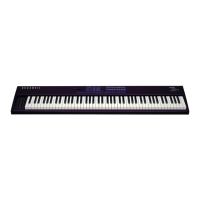Chapter 6
Advanced Applications
You will Þnd that your SP76 or SP88 is superb for straight-ahead solo or ensemble
playing on stage and at home. With the addition of external equipment though it can
do much more and can form the core of your own personal MIDI studio.
This chapter will present a few ideas to get you started but there are many, many more
possibilities as well. Although Kurzweil equipment is cited in these examples, there is
a whole world of possibilities out there and your Stage Piano will be equally adept at
using any of them.
External Sound Modules
The simplest advanced application is using your Stage Piano with an external sound
module or synthesizer. Refer to page 2-6 for the connections required when using a
single external module.
As you have read, the Stage PianoÕs internal sound module is basically a solo (often
termed monotimbral) device that can play one voice at a time. Actually, itÕs better to call
these voices sound programs because a few, like 7 Piano and Strings 1, are layers of two
different voices playing simultaneously. Still, all notes received by the internal module
will play the same sound program.
Example: The Kurzweil MicroPiano
Even a very simple external module, like a Kurzweil MicroPiano (which is also
monotimbral), will allow you to make use of your Stage PianoÕs two zones. Try this as
a starting point for making MIDI Setups:
Internal Sound Set to the sound you wish to use.
MIDI Program Set Zone L to the MicroPiano voice you wish to use.
MIDI Channel Set Zone L to Channel 1 and make sure the MicroPiano is set to
receive on Channel 1.
Destination Set Zone L to MID and Zone R to Int.
Key Range Set Low and High parameters in each zone to the key ranges you
wish each module to respond to.
Other parameters Unless theyÕve been changed, the default settings for the
remaining zones and parameters are suitable for starters.

